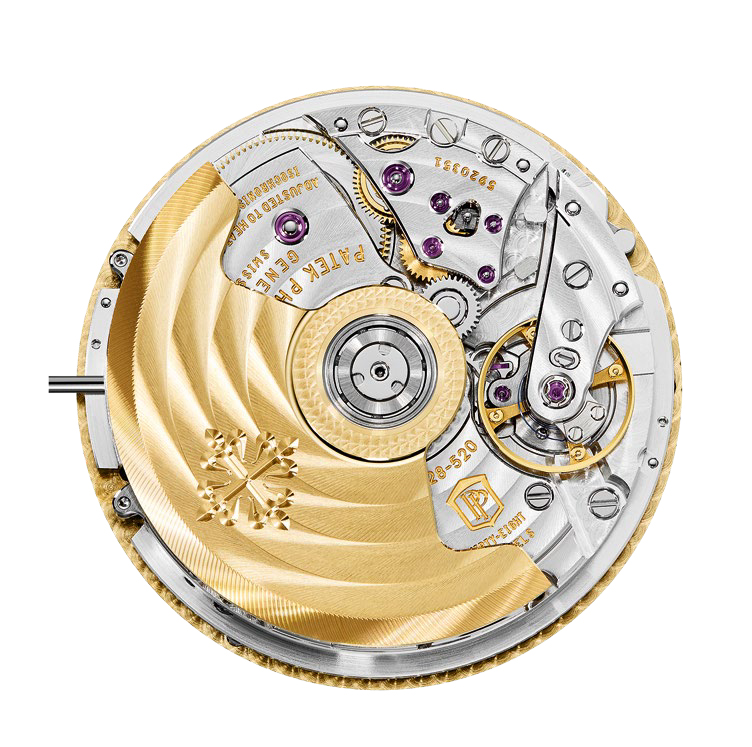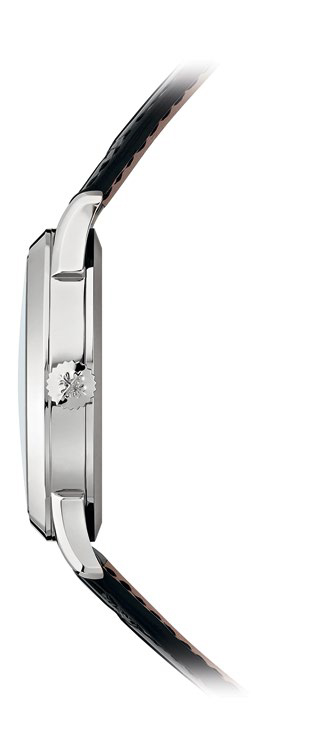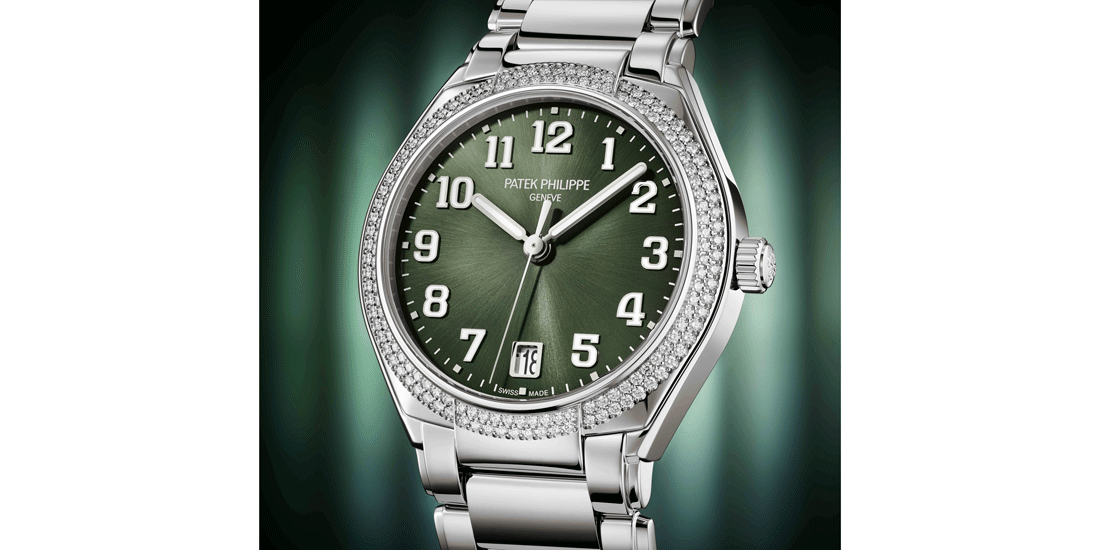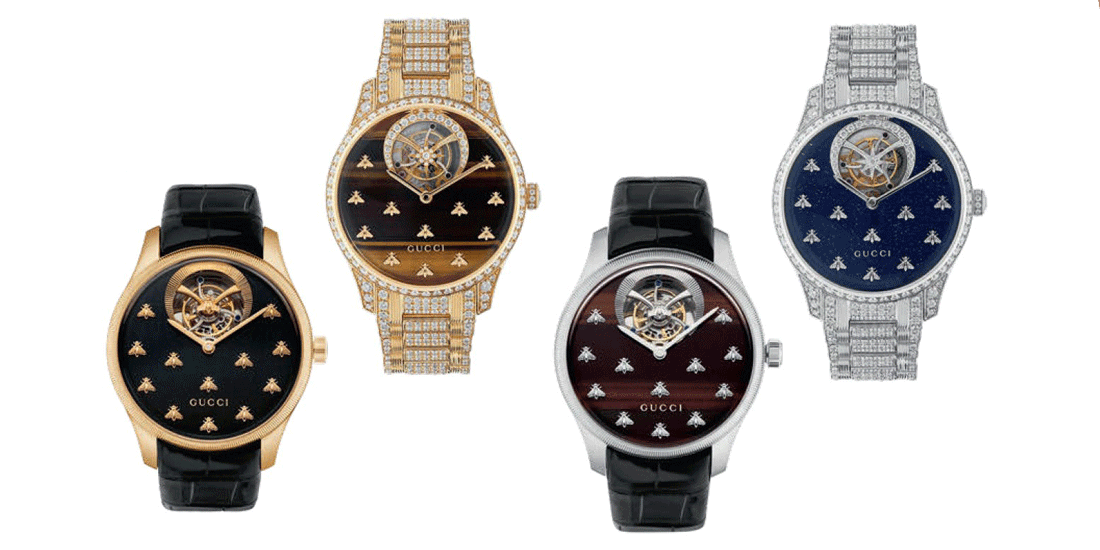
Patek Philippe Reference World Time Chronograph 5930
CASE : 18K white gold, sapphire crystal caseback, water-resistant to 30m
DIAMETER : 39.5mm
MOVEMENT: mechanical self-winding (Caliber CH 28-520 HU, 50h power reserve), 343 parts, column-wheel chronograph, vertical clutch, central rotor in 21K gold, unidirectional winding
FUNCTIONS : hours, minutes, seconds, chronograph, day/night indication, 24 time zones
DIAL : three zones, handguilloché navy blue center, applied batontype hour-markers in 18K white gold and Dauphinetype hours and minutes hands
STRAP : hand-stitched alligator with large square scales, matt navy blue with folding clasp in 18K white gold
The rigorous nature of the tests required to combine these two complications is reflected in the pleasing aesthetics and reliable long-term precision.
There is no point searching for a historical collection from which the creators of this 2016 new release might have drawn inspiration, since a 1940 one-of-a-kind wristwatch in the Patek Philippe Museum is the only known piece combining these two complications that are now united in the World Time Chronograph 5930 which is joining the Complications line. It perfectly embodies the symbiosis of two skills for which Patek Philippe is particularly renowned, which are much coveted by collectors and should destine this Haute Horlogerie model to a brilliant future. The entire GMT team is extremely proud to feature this exceptional watch on the magazine cover.
 Patek Philippe’s acknowledged experience and track record in each of these mechanical disciplines notwithstanding, this historical expertise in no way guaranteed that the two horological complications could be associated and interlocked in such a way as to meet the extremely demanding criteria of the Patek Philippe Seal. 21st century technical standards are high, the mechanisms are more complex than ever, and both the chronograph and World Time are by definition the kind of complications that require considerable space for the numerous indications : 24 time zones and as many cities for the former ; and counters as well as a central sweep-seconds hand for the latter. Months of research and development, along with stringent testing, were required to twin them with rigorous precision, while ensuring this alliance is compatible with Patek Philippe’s ongoing quest for aesthetic and technical perfection. This ambitious approach gave rise to a new mechanical movement, adjusted to the nearest hundredth of a millimeter to guarantee enduring reliability. While Caliber CH 28-520 HU is indeed based on the mechanical self-winding CH-28-520 PS chronograph caliber with column-wheel control and a vertical clutch, as well as the famous World Time module that was optimized to include two important refinements patented in 1959 and 1999, the mechanism has been entirely adapted. Axes were shifted, bridges thinned and newly designed, and component clearances changed so that the mechanisms could be smoothly recombined. Thanks to the vertical clutch, the chronograph hand can also serve as a permanently running seconds hand with a minimum of wear and without negatively influencing the rate accuracy and power reserve of the watch
Patek Philippe’s acknowledged experience and track record in each of these mechanical disciplines notwithstanding, this historical expertise in no way guaranteed that the two horological complications could be associated and interlocked in such a way as to meet the extremely demanding criteria of the Patek Philippe Seal. 21st century technical standards are high, the mechanisms are more complex than ever, and both the chronograph and World Time are by definition the kind of complications that require considerable space for the numerous indications : 24 time zones and as many cities for the former ; and counters as well as a central sweep-seconds hand for the latter. Months of research and development, along with stringent testing, were required to twin them with rigorous precision, while ensuring this alliance is compatible with Patek Philippe’s ongoing quest for aesthetic and technical perfection. This ambitious approach gave rise to a new mechanical movement, adjusted to the nearest hundredth of a millimeter to guarantee enduring reliability. While Caliber CH 28-520 HU is indeed based on the mechanical self-winding CH-28-520 PS chronograph caliber with column-wheel control and a vertical clutch, as well as the famous World Time module that was optimized to include two important refinements patented in 1959 and 1999, the mechanism has been entirely adapted. Axes were shifted, bridges thinned and newly designed, and component clearances changed so that the mechanisms could be smoothly recombined. Thanks to the vertical clutch, the chronograph hand can also serve as a permanently running seconds hand with a minimum of wear and without negatively influencing the rate accuracy and power reserve of the watch
Simplicity serving complexity
 A complex watch is a real success when it is truly user friendly. The two functions of this World Time self-winding chronograph are indeed extremely easy to handle. The central hours and minutes indicate the time in the city and time zone whose name is shown at 12 o’clock. The time in the 23 other zones can be read off at a glance via the city disk and the 24-hour ring located nearer the center. The division of the latter into blue and white zones indicates whether it is day or night in the given location. Patek Philippe has also updated the city scale on which some time zones are defined by new place names – such as Dubai which replaces Riyadh and Buenos Aires that takes over from Rio – while others have undergone a change in local time, such as Moscow which has switched from UTC+4 to UTC+3. When the traveler arrives in a new time zone, all he needs to do is press the corrector button at 10 o’clock. The city disk and the 24-hour ring advance counterclockwise in one-hour steps, while the central hand moves clockwise, also in one-hour jumps. The correction is complete when the city name of the destination time zone is at 12 o’clock. During this process, the World Time mechanism and the hours hand are uncoupled from the base movement so that neither the amplitude of the balance nor the precision of the minutes hand are affected. The chronograph hand keeps moving without the slightest irregularity. The latter is operated via a start/stop pusher at 2 o’clock and a reset pusher at 4 o’clock that also doubles as a flyback pusher. When it is pressed while the chronograph is running, the chronograph hand hand flies back to zero and a new time measurement begins. The seconds scale for chronograph measurements appears between the city disk and the 24-hour ring, in the form of a narrow white circular scale with ultra-precise fourth-of-a-second graduations, thus enabling measurements accurate to the nearest eighth of a second.
A complex watch is a real success when it is truly user friendly. The two functions of this World Time self-winding chronograph are indeed extremely easy to handle. The central hours and minutes indicate the time in the city and time zone whose name is shown at 12 o’clock. The time in the 23 other zones can be read off at a glance via the city disk and the 24-hour ring located nearer the center. The division of the latter into blue and white zones indicates whether it is day or night in the given location. Patek Philippe has also updated the city scale on which some time zones are defined by new place names – such as Dubai which replaces Riyadh and Buenos Aires that takes over from Rio – while others have undergone a change in local time, such as Moscow which has switched from UTC+4 to UTC+3. When the traveler arrives in a new time zone, all he needs to do is press the corrector button at 10 o’clock. The city disk and the 24-hour ring advance counterclockwise in one-hour steps, while the central hand moves clockwise, also in one-hour jumps. The correction is complete when the city name of the destination time zone is at 12 o’clock. During this process, the World Time mechanism and the hours hand are uncoupled from the base movement so that neither the amplitude of the balance nor the precision of the minutes hand are affected. The chronograph hand keeps moving without the slightest irregularity. The latter is operated via a start/stop pusher at 2 o’clock and a reset pusher at 4 o’clock that also doubles as a flyback pusher. When it is pressed while the chronograph is running, the chronograph hand hand flies back to zero and a new time measurement begins. The seconds scale for chronograph measurements appears between the city disk and the 24-hour ring, in the form of a narrow white circular scale with ultra-precise fourth-of-a-second graduations, thus enabling measurements accurate to the nearest eighth of a second.
Tradition without borders
The show continues on the back, in a notably dynamic way on the oscillating weight decorated with circular “Côtes de Genève” and an engraved Calatrava cross, while the center of the rotor is finely circular-grained. More “static” yet creating infinitely shimmering reflections, the circular graining is repeated on the rhodiumed bridges with polished chamfers and countersinks, along with gilt engraving in compliance with the Patek Philippe Seal criteria. These elements make a fine contrast with the gleaming red bearing jewels, the golden hue of the Gyromax® balance and the purpleblue shimmer of the patented Spiromax® balance spring in Silinvar®. Thanks to its Patek Philippe terminal curve, this balance spring combines the concentric breathing of a Breguet hairspring with the slim build of a classic flat balance spring. The movement is neatly fitted into a classic round case in 18K white gold. Its winglet-style strap lugs echo a characteristic detail of the 1940s and 1950s World Time watches. Finally, the time-zone correction button, unsurprisingly positioned at 10 o’clock, features a rectangular contour identical to that of the two chronograph pushers. Their shape is a recurrent theme on the classic chronographs from the Manufacture. The result is a chronograph on which the sun never sets thanks to its 24 time zones ; and who would not wish for such a marvel to grace a personal collection and be passed on to future generations ?
See also : Patek Philippe – Heure Universelle référence 5230





